charging SKODA ROOMSTER 2010 1.G Owner's Manual
[x] Cancel search | Manufacturer: SKODA, Model Year: 2010, Model line: ROOMSTER, Model: SKODA ROOMSTER 2010 1.GPages: 231, PDF Size: 12.91 MB
Page 102 of 231
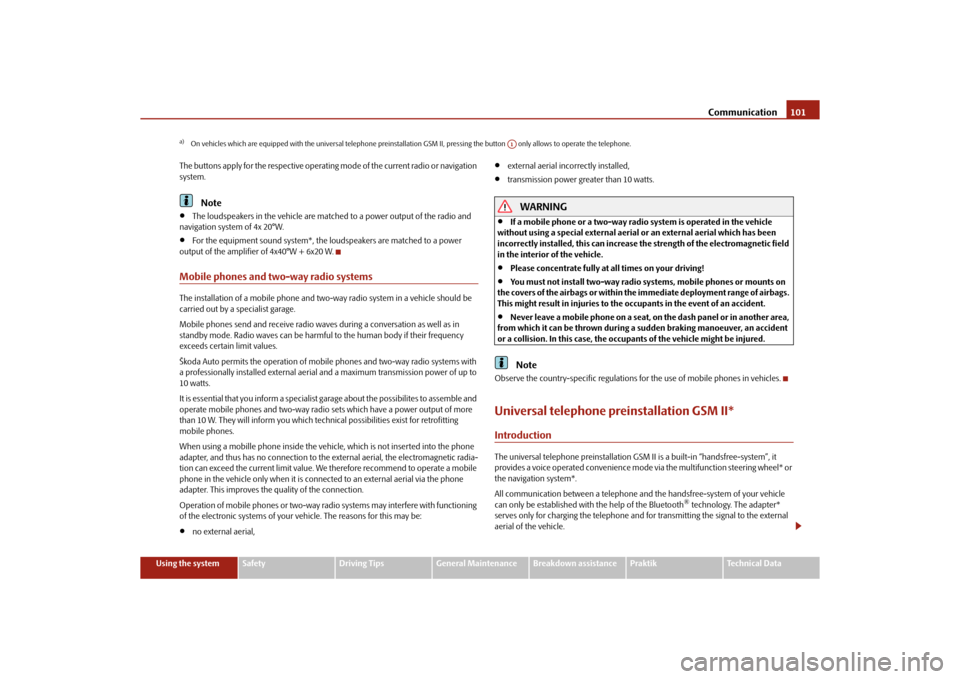
Communication101
Using the system
Safety
Driving Tips
General Maintenance
Breakdown assistance
Praktik
Technical Data
The buttons apply for the respective operating mode of the current radio or navigation
system.
Note
The loudspeakers in the vehicle are matched to a power output of the radio and
navigation system of 4x 20°W.
For the equipment sound system*, the loudspeakers are matched to a power
output of the amplifier of 4x40°W + 6x20 W.
Mobile phones and tw o-way radio systemsThe installation of a mobile phone and two-way radio system in a vehicle should be
carried out by a specialist garage.
Mobile phones send and receive radio waves during a conversation as well as in
standby mode. Radio waves can be harmful to the human body if their frequency
exceeds certain limit values.
Škoda Auto permits the operation of mobile phones and two-way radio systems with
a professionally installed external aerial and a maximum transmission power of up to
10 watts.
It is essential that you inform a specialist garage about the possibilites to assemble and
operate mobile phones and two-way radio sets which have a power output of more
than 10 W. They will inform you which technical possibilities exist for retrofitting
mobile phones.
When using a mobille phone inside the vehicl e, which is not inserted into the phone
adapter, and thus has no connection to the external aerial, the electromagnetic radia-
tion can exceed the current limit value. We therefore recommend to operate a mobile
phone in the vehicle only when it is conne cted to an external aerial via the phone
adapter. This improves the quality of the connection.
Operation of mobile phones or two-way ra dio systems may interfere with functioning
of the electronic systems of your vehicle. The reasons for this may be:
no external aerial,
external aerial incorrectly installed,
transmission power gr eater than 10 watts.
WARNING
If a mobile phone or a two-way radio system is operated in the vehicle
without using a special external aerial or an external aerial which has been
incorrectly installed, this can increase the strength of the electromagnetic field
in the interior of the vehicle.
Please concentrate fully at all times on your driving!
You must not install two-way radio systems, mobile phones or mounts on
the covers of the airbags or within the immediate deployment range of airbags.
This might result in injuries to the occupants in the event of an accident.
Never leave a mobile phone on a seat, on the dash panel or in another area,
from which it can be thrown during a sudden braking manoeuver, an accident
or a collision. In this case, the occupants of the vehicle might be injured.Note
Observe the country-specific regulations for the use of mobile phones in vehicles.Universal telephone preinstallation GSM II*IntroductionThe universal telephone preinstallation GSM II is a built-in “handsfree-system”, it
provides a voice operated convenience mode via the multifunction steering wheel* or
the navigation system*.
All communication between a telephone and the handsfree-system of your vehicle
can only be established with the help of the Bluetooth
® technology. The adapter*
serves only for charging the telephone and fo r transmitting the signal to the external
aerial of the vehicle.
a)On vehicles which are equipped with the universal telephone prei nstallation GSM II, pressing the button only allows to operate the telephone.
A1
s16g.4.book Page 101 Wednesday, February 10, 2010 3:53 PM
Page 104 of 231
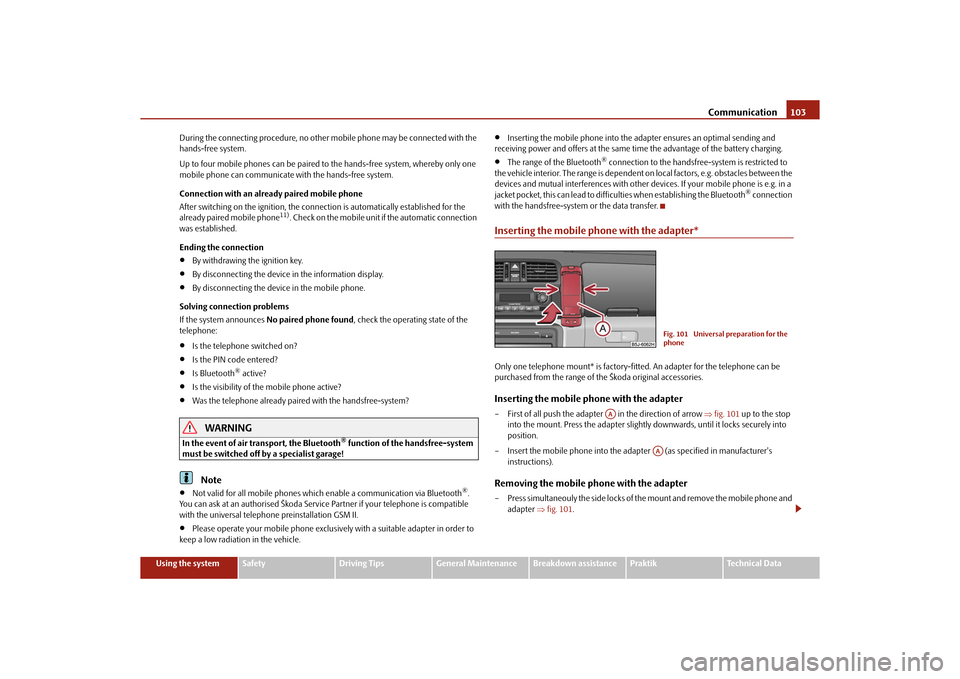
Communication103
Using the system
Safety
Driving Tips
General Maintenance
Breakdown assistance
Praktik
Technical Data
During the connecting procedur
e, no other mobile phone may be connected with the
hands-free system.
Up to four mobile phones can be paired to the hands-free system, whereby only one
mobile phone can communicate with the hands-free system.
Connection with an already paired mobile phone
After switching on the ignition, the connect ion is automatically established for the
already paired mobile phone
11). Check on the mobile unit if the automatic connection
was established.
Ending the connection
By withdrawing the ignition key.
By disconnecting the device in the information display.
By disconnecting the device in the mobile phone.
Solving connection problems
If the system announces No paired phone found , check the operating state of the
telephone:
Is the telephone switched on?
Is the PIN code entered?
Is Bluetooth
® active?
Is the visibility of the mobile phone active?
Was the telephone already paired with the handsfree-system?
WARNING
In the event of air transport, the Bluetooth
® function of the handsfree-system
must be switched off by a specialist garage!
Note
Not valid for all mobile phones which enable a communication via Bluetooth
®.
You can ask at an authorised Škoda Service Partner if your telephone is compatible
with the universal telephone preinstallation GSM II.
Please operate your mobile phone exclusiv ely with a suitable adapter in order to
keep a low radiation in the vehicle.
Inserting the mobile phone into the adapter ensures an optimal sending and
receiving power and offers at the same ti me the advantage of the battery charging.
The range of the Bluetooth
® connection to the handsfree-system is restricted to
the vehicle interior. The range is dependent on local factors, e.g. obstacles between the
devices and mutual interferences with other de vices. If your mobile phone is e.g. in a
jacket pocket, this can lead to diffic ulties when establishing the Bluetooth
® connection
with the handsfree-system or the data transfer.
Inserting the mobile phone with the adapter*Only one telephone mount* is factory-fitted. An adapter for the telephone can be
purchased from the range of the Škoda original accessories.Inserting the mobile phone with the adapter– First of all push the adapter in the direction of arrow fig. 101 up to the stop
into the mount. Press the adapter slightly downwards, until it locks securely into
position.
– Insert the mobile phone into the adapter (as specified in manufacturer's instructions).Removing the mobile phone with the adapter– Press simultaneouly the side locks of the mount and remove the mobile phone and adapter fig. 101 .
Fig. 101 Universal preparation for the
phone
AA
AA
s16g.4.book Page 103 Wednesda y, February 10, 2010 3:53 PM
Page 105 of 231
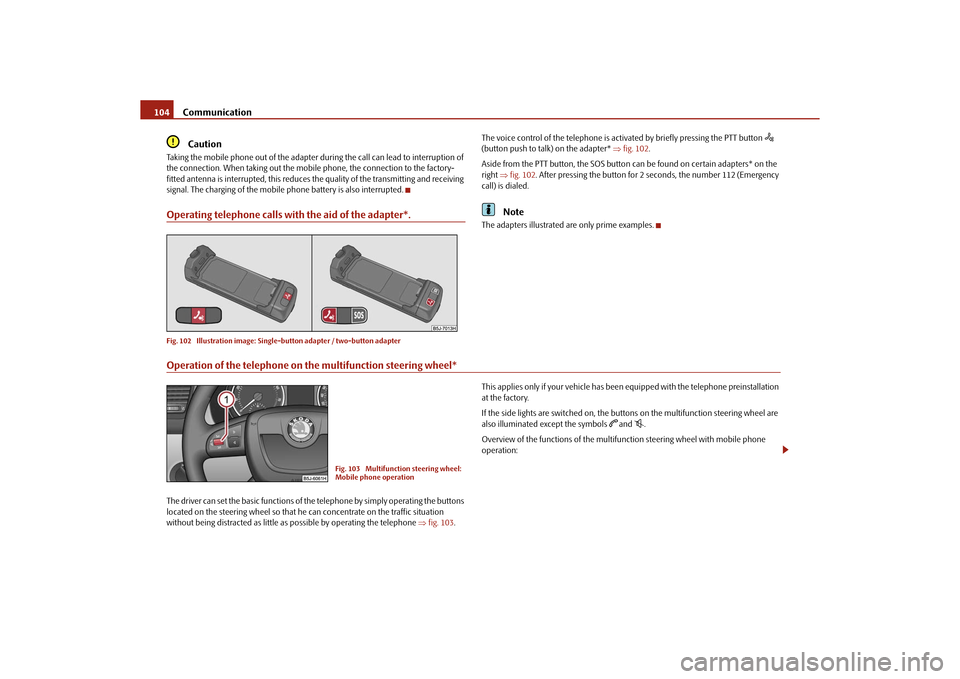
Communication
104Caution
Taking the mobile phone out of the adapter du ring the call can lead to interruption of
the connection. When taking out the mobile phone, the connection to the factory-
fitted antenna is interrupted, this reduces the quality of the transmitting and receiving
signal. The charging of the mobile phone battery is also interrupted.Operating telephone calls with the aid of the adapter*.Fig. 102 Illustration image: Single -button adapter / two-button adapter
The voice control of the telephone is acti vated by briefly pressing the PTT button
(button push to talk) on the adapter* fig. 102 .
Aside from the PTT button, the SOS button can be found on certain adapters* on the
right fig. 102 . After pressing the button for 2 seconds, the number 112 (Emergency
call) is dialed.
Note
The adapters illustrated are only prime examples.
Operation of the telephone on the multifunction steering wheel*The driver can set the basic functions of the telephone by simply operating the buttons
located on the steering whee l so that he can concentrate on the traffic situation
without being distracted as little as possible by operating the telephone fig. 103 . This applies only if your vehicle has been equipped with the telephone preinstallation
at the factory.
If the side lights are switched on, the buttons on the multifunction steering wheel are
also illuminated except the symbols
and
.
Overview of the functions of the multifunction steering wheel with mobile phone
operation:
Fig. 103 Multifunction steering wheel:
Mobile phone operation
s16g.4.book Page 104 Wednesda y, February 10, 2010 3:53 PM
Page 171 of 231
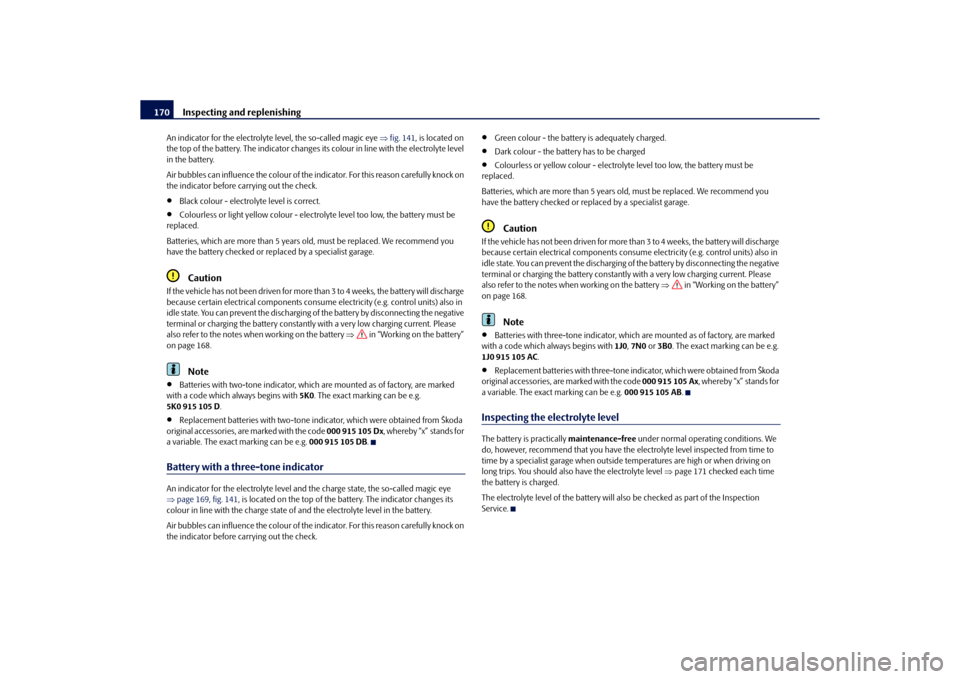
Inspecting and replenishing
170
An indicator for the electrolyte level, the so-called magic eye fig. 141 , is located on
the top of the battery. The indicator changes it s colour in line with the electrolyte level
in the battery.
Air bubbles can influence the colour of the in dicator. For this reason carefully knock on
the indicator before carrying out the check.
Black colour - electrolyte level is correct.
Colourless or light yellow colour - electrolyte level too low, the battery must be
replaced.
Batteries, which are more than 5 years old, must be replaced. We recommend you
have the battery checked or replaced by a specialist garage.Caution
If the vehicle has not been driven for more than 3 to 4 weeks, the battery will discharge
because certain electrical components consum e electricity (e.g. control units) also in
idle state. You can prevent the discharging of the battery by disconnecting the negative
terminal or charging the battery constantly with a very low charging current. Please
also refer to the notes wh en working on the battery in “Working on the battery”
on page 168.
Note
Batteries with two-tone indicator, which are mounted as of factory, are marked
with a code which always begins with 5K0. The exact marking can be e.g.
5K0 915 105 D .
Replacement batteries with two-tone indi cator, which were obtained from Škoda
original accessories, are marked with the code 000 915 105 Dx, whereby “x” stands for
a variable. The exact marking can be e.g. 000 915 105 DB.
Battery with a three-tone indicatorAn indicator for the electrolyte level and the charge state, the so-called magic eye
page 169, fig. 141 , is located on the top of the ba ttery. The indicator changes its
colour in line with the charge state of and the electrolyte level in the battery.
Air bubbles can influence the colour of the in dicator. For this reason carefully knock on
the indicator before carrying out the check.
Green colour - the battery is adequately charged.
Dark colour - the battery has to be charged
Colourless or yellow colour - electrolyte level too low, the battery must be
replaced.
Batteries, which are more than 5 years old, must be replaced. We recommend you
have the battery checked or replaced by a specialist garage.Caution
If the vehicle has not been driven for more than 3 to 4 weeks, the battery will discharge
because certain electrical components consume electricity (e .g. control units) also in
idle state. You can prevent the discharging of the battery by disconnecting the negative
terminal or charging the battery constantly with a very low charging current. Please
also refer to the notes when working on the battery in “Working on the battery”
on page 168.
Note
Batteries with three-tone indicator, which are mounted as of factory, are marked
with a code which always begins with 1J0, 7N0 or 3B0 . The exact marking can be e.g.
1J0 915 105 AC .
Replacement batteries with three-tone indi cator, which were obtained from Škoda
original accessories, are marked with the code 000 915 105 Ax, whereby “x” stands for
a variable. The exact marking can be e.g. 000 915 105 AB.
Inspecting the electrolyte levelThe battery is practically maintenance-free under normal operating conditions. We
do, however, recommend that you have the electrolyte level inspected from time to
time by a specialist garage when outside temperatures are high or when driving on
long trips. You should also have the electrolyte level page 171 checked each time
the battery is charged.
The electrolyte level of the battery will al so be checked as part of the Inspection
Service.
s16g.4.book Page 170 Wednesda y, February 10, 2010 3:53 PM
Page 172 of 231
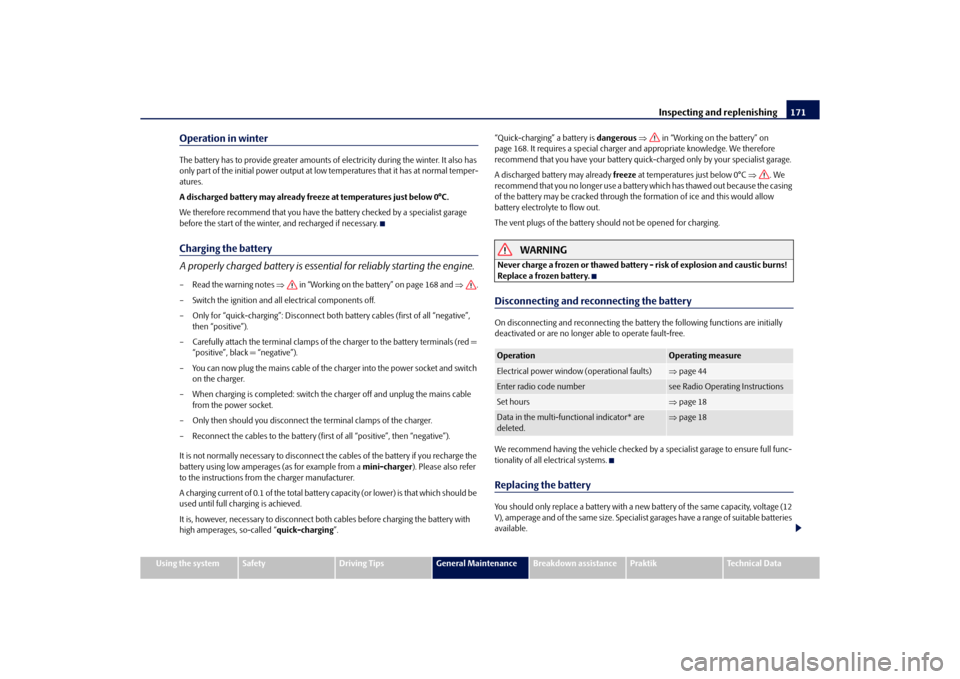
Inspecting and replenishing171
Using the system
Safety
Driving Tips
General Maintenance
Breakdown assistance
Praktik
Technical Data
Operation in winterThe battery has to provide greater amounts of electricity during the winter. It also has
only part of the initial power output at low temperatures that it has at normal temper-
atures.
A discharged battery may already freez e at temperatures just below 0°C.
We therefore recommend that you have the battery checked by a specialist garage
before the start of the winter, and recharged if necessary.Charging the battery
A properly charged battery is essentia l for reliably starting the engine.– Read the warning notes in “Working on the battery” on page 168 and .
– Switch the ignition and all electrical components off.
– Only for “quick-charging”: Disconnect both battery cables (first of all “negative”,
then “positive”).
– Carefully attach the terminal clamps of the charger to the battery terminals (red = “positive”, black = “negative”).
– You can now plug the mains cable of the charger into the power socket and switch
on the charger.
– When charging is completed: switch th e charger off and unplug the mains cable
from the power socket.
– Only then should you disconnect the terminal clamps of the charger.
– Reconnect the cables to the battery (first of all “positive”, then “negative”).
It is not normally necessary to disconnect th e cables of the battery if you recharge the
battery using low amperages (as for example from a mini-charger ). Please also refer
to the instructions from the charger manufacturer.
A charging current of 0.1 of the total battery capacity (or lower) is that which should be
used until full charging is achieved.
It is, however, necessary to disconnect both cables before charging the battery with
high amperages, so-called “ quick-charging”. “Quick-charging” a battery is
dangerous in “Working on the battery” on
page 168. It requires a special charger an d appropriate knowledge. We therefore
recommend that you have your battery quick- charged only by your specialist garage.
A discharged battery may already freeze at temperatures just below 0°C . We
recommend that you no longer use a battery which has thawed out because the casing
of the battery may be cracked through the formation of ice and this would allow
battery electrolyte to flow out.
The vent plugs of the battery should not be opened for charging.
WARNING
Never charge a frozen or thawed battery - risk of explosion and caustic burns!
Replace a frozen battery.Disconnecting and reconnecting the batteryOn disconnecting and reconnecting the battery the following functions are initially
deactivated or are no longer able to operate fault-free.
We recommend having the vehicle checked by a specialist garage to ensure full func-
tionality of all electrical systems.Replacing the batteryYou should only replace a battery with a ne w battery of the same capacity, voltage (12
V), amperage and of the same size. Specialist garages have a range of suitable batteries
available.Operation
Operating measure
Electrical power window (operational faults)
page 44
Enter radio code number
see Radio Operating Instructions
Set hours
page 18
Data in the multi-functional indicator* are
deleted.
page 18
s16g.4.book Page 171 Wednesda y, February 10, 2010 3:53 PM
Page 222 of 231
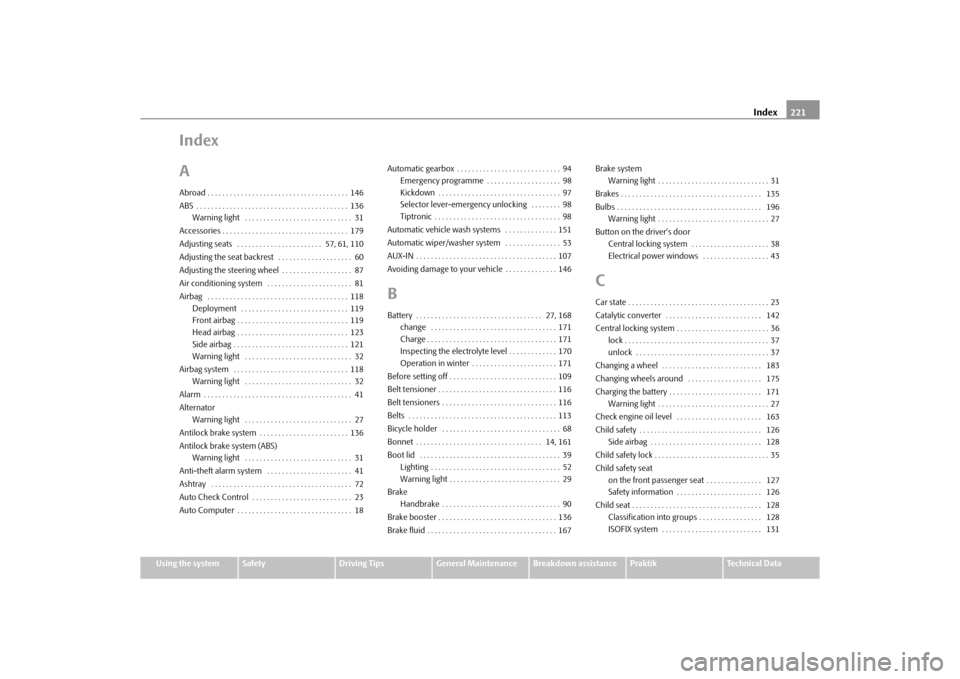
Index221
Using the system
Safety
Driving Tips
General Maintenance
Breakdown assistance
Praktik
Technical Data
Index
AAbroad . . . . . . . . . . . . . . . . . . . . . . . . . . . . . . . . . . . . . . 146
ABS . . . . . . . . . . . . . . . . . . . . . . . . . . . . . . . . . . . . . . . . . 136
Warning light . . . . . . . . . . . . . . . . . . . . . . . . . . . . . 31
Accessories . . . . . . . . . . . . . . . . . . . . . . . . . . . . . . . . . . 179
Adjusting seats . . . . . . . . . . . . . . . . . . . . . . . 57, 61, 110
Adjusting the seat backrest . . . . . . . . . . . . . . . . . . . . 60
Adjusting the steering wheel . . . . . . . . . . . . . . . . . . . 87
Air conditioning system . . . . . . . . . . . . . . . . . . . . . . . 81
Airbag . . . . . . . . . . . . . . . . . . . . . . . . . . . . . . . . . . . . . . 118 Deployment . . . . . . . . . . . . . . . . . . . . . . . . . . . . . 119
Front airbag . . . . . . . . . . . . . . . . . . . . . . . . . . . . . . 119
Head airbag . . . . . . . . . . . . . . . . . . . . . . . . . . . . . . 123
Side airbag . . . . . . . . . . . . . . . . . . . . . . . . . . . . . . . 121
Warning light . . . . . . . . . . . . . . . . . . . . . . . . . . . . . 32
Airbag system . . . . . . . . . . . . . . . . . . . . . . . . . . . . . . . 118 Warning light . . . . . . . . . . . . . . . . . . . . . . . . . . . . . 32
Alarm . . . . . . . . . . . . . . . . . . . . . . . . . . . . . . . . . . . . . . . . 41
Alternator Warning light . . . . . . . . . . . . . . . . . . . . . . . . . . . . . 27
Antilock brake system . . . . . . . . . . . . . . . . . . . . . . . . 136
Antilock brake system (ABS) Warning light . . . . . . . . . . . . . . . . . . . . . . . . . . . . . 31
Anti-theft alarm system . . . . . . . . . . . . . . . . . . . . . . . 41
Ashtray . . . . . . . . . . . . . . . . . . . . . . . . . . . . . . . . . . . . . . 72
Auto Check Control . . . . . . . . . . . . . . . . . . . . . . . . . . . 23
Auto Computer . . . . . . . . . . . . . . . . . . . . . . . . . . . . . . . 18 Automatic gearbox . . . . . . . . . . . . . . . . . . . . . . . . . . . . 94
Emergency programme . . . . . . . . . . . . . . . . . . . . 98
Kickdown . . . . . . . . . . . . . . . . . . . . . . . . . . . . . . . . . 97
Selector lever-emergency unlocking . . . . . . . . 98
Tiptronic . . . . . . . . . . . . . . . . . . . . . . . . . . . . . . . . . . 98
Automatic vehicle wash systems . . . . . . . . . . . . . . 151
Automatic wiper/washer system . . . . . . . . . . . . . . . 53
AUX-IN . . . . . . . . . . . . . . . . . . . . . . . . . . . . . . . . . . . . . . 107
Avoiding damage to your vehicle . . . . . . . . . . . . . . 146
BBattery . . . . . . . . . . . . . . . . . . . . . . . . . . . . . . . . . . 27, 168 change . . . . . . . . . . . . . . . . . . . . . . . . . . . . . . . . . . 171
Charge . . . . . . . . . . . . . . . . . . . . . . . . . . . . . . . . . . . 171
Inspecting the electrolyte level . . . . . . . . . . . . . 170
Operation in winter . . . . . . . . . . . . . . . . . . . . . . . 171
Before setting off . . . . . . . . . . . . . . . . . . . . . . . . . . . . . 109
Belt tensioner . . . . . . . . . . . . . . . . . . . . . . . . . . . . . . . . 116
Belt tensioners . . . . . . . . . . . . . . . . . . . . . . . . . . . . . . . 116
Belts . . . . . . . . . . . . . . . . . . . . . . . . . . . . . . . . . . . . . . . . 113
Bicycle holder . . . . . . . . . . . . . . . . . . . . . . . . . . . . . . . . 68
Bonnet . . . . . . . . . . . . . . . . . . . . . . . . . . . . . . . . . . 14, 161
Boot lid . . . . . . . . . . . . . . . . . . . . . . . . . . . . . . . . . . . . . . 39 Lighting . . . . . . . . . . . . . . . . . . . . . . . . . . . . . . . . . . . 52
Warning light . . . . . . . . . . . . . . . . . . . . . . . . . . . . . . 29
Brake Handbrake . . . . . . . . . . . . . . . . . . . . . . . . . . . . . . . . 90
Brake booster . . . . . . . . . . . . . . . . . . . . . . . . . . . . . . . . 136
Brake fluid . . . . . . . . . . . . . . . . . . . . . . . . . . . . . . . . . . . 167 Brake system
Warning light . . . . . . . . . . . . . . . . . . . . . . . . . . . . . . 31
Brakes . . . . . . . . . . . . . . . . . . . . . . . . . . . . . . . . . . . . . . 135
Bulbs . . . . . . . . . . . . . . . . . . . . . . . . . . . . . . . . . . . . . . . 196 Warning light . . . . . . . . . . . . . . . . . . . . . . . . . . . . . . 27
Button on the driver's door Central locking system . . . . . . . . . . . . . . . . . . . . . 38
Electrical power windows . . . . . . . . . . . . . . . . . . 43
CCar state . . . . . . . . . . . . . . . . . . . . . . . . . . . . . . . . . . . . . . 23
Catalytic converter . . . . . . . . . . . . . . . . . . . . . . . . . . 142
Central locking system . . . . . . . . . . . . . . . . . . . . . . . . . 36lock . . . . . . . . . . . . . . . . . . . . . . . . . . . . . . . . . . . . . . . 37
unlock . . . . . . . . . . . . . . . . . . . . . . . . . . . . . . . . . . . . 37
Changing a wheel . . . . . . . . . . . . . . . . . . . . . . . . . . . 183
Changing wheels around . . . . . . . . . . . . . . . . . . . . 175
Charging the battery . . . . . . . . . . . . . . . . . . . . . . . . . 171 Warning light . . . . . . . . . . . . . . . . . . . . . . . . . . . . . . 27
Check engine oil level . . . . . . . . . . . . . . . . . . . . . . . 163
Child safety . . . . . . . . . . . . . . . . . . . . . . . . . . . . . . . . . 126 Side airbag . . . . . . . . . . . . . . . . . . . . . . . . . . . . . . 128
Child safety lock . . . . . . . . . . . . . . . . . . . . . . . . . . . . . . . 35
Child safety seat on the front passenger seat . . . . . . . . . . . . . . . 127
Safety information . . . . . . . . . . . . . . . . . . . . . . . 126
Child seat . . . . . . . . . . . . . . . . . . . . . . . . . . . . . . . . . . . 128 Classification into groups . . . . . . . . . . . . . . . . . 128
ISOFIX system . . . . . . . . . . . . . . . . . . . . . . . . . . . 131
s16g.4.book Page 221 Wednesda y, February 10, 2010 3:53 PM